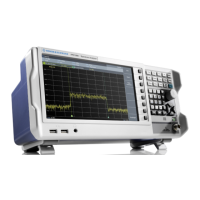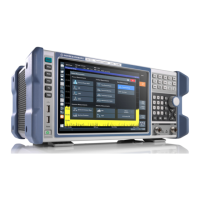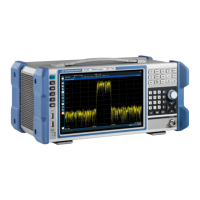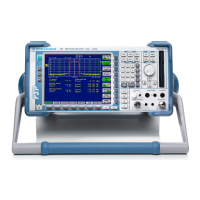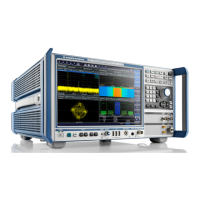Do you have a question about the Rohde & Schwarz FPC1500 and is the answer not in the manual?
Instructions to prevent personal injury or damage to the instrument.
Contains safety instructions, operating conditions, and important information.
Warning about disregarding safety information and its consequences.
Precautions against electrostatic discharge (ESD) to prevent instrument damage.
Steps for carefully unpacking and checking the R&S FPC and its package contents.
Guidance on placing or mounting the R&S FPC for optimal use.
Overview of connectors and controls on the front panel of the R&S FPC.
Overview of connectors and controls on the rear panel of the R&S FPC.
Operating the R&S FPC manually using front panel keys.
Operating the R&S FPC remotely from another computer.
Steps and recommendations for updating the R&S FPC firmware.
Steps to restore default instrument configuration or user-defined settings.
Resets the R&S FPC to its default state using preset modes.
Warning about data loss when resetting to factory state.
Initiates an instrument reset back to factory settings.
Steps to reset the system to factory settings.
Selects the preset mode: Default or User-defined.
Selects a dataset for a user-defined preset state.
Connecting the R&S FPC to LAN or WLAN for remote control or software updates.
How to use the file manager to manage files in internal memory or on external devices.
Steps for saving the current measurement configuration and results as a dataset.
Steps for restoring saved measurement configurations and results.
How to take and store screenshots of the current screen.
Selecting the signal source mode (Off, CW, CW Coupled, Tracking Generator).
Setting the output level of the generated signal.
Overview of different calibration types available.
Importance of specifying the correct calibration kit for phase error avoidance.
Steps to perform default calibration and its effects on presets.
Activating correction after normalization or calibration for accurate results.
Starting and using the measurement wizard to perform sequences.
Steps to select and access the Spectrum application.
Quick access to important measurement settings in a single dialog box.
Steps to select and start the channel power measurement.
Steps to perform a third order intermodulation (TOI) measurement.
Steps to select and start a TDMA power measurement.
Steps to select and start the harmonic distortion measurement.
Steps to measure AM modulation depth by placing markers.
Steps to select and start the occupied bandwidth (OBW) measurement.
Displaying the spectrogram in two windows: spectrum trace and spectrogram.
Steps to select and access the Receiver application.
Steps to select and access the Analog Demodulation application.
Creating and evaluating limit values for AM/FM measurements.
Steps to select and access the Digital Demodulation application.
Selecting filters, defining symbol rate, roll-off factor, and burst processing.
Configuring trigger sources and levels for I/Q power trigger.
Steps to select and access the Vector Network Analyzer application.
Characterizing networks by measuring reflection or transmission.
Defining frequency range and settings for VNA measurements.
Adjusting amplitude settings like reference level and display range.
Configuring resolution bandwidth for VNA measurements.
Controlling measurement sweep parameters like mode and number of points.
Configuring trace modes and memory traces for VNA measurements.
Configuring marker types, positions, and search ranges for VNA measurements.
Configuring limit lines for VNA measurements.
Introduction to remote control, interfaces, SCPI, and protocols.
Commands to configure trigger slope, level, source, and delay.
Commands for noise measurement, frequency counter, and bandwidth.
Commands to configure display lines and limit checks.
Selects the resolution bandwidth (or measurement bandwidth).
Selects the video bandwidth.
Defining how often the data is measured (continuous or single).
Commands to configure amplitude settings like reference level and range.
Commands to control measurement sweep parameters.
Commands to configure trace style and detector.
Commands to configure frequency settings like center, span, and coupling.
Commands to configure resolution bandwidth.
Commands to control measurement sweep parameters.
Commands to configure trace modes and memory.
Commands to configure marker state, position, and type.
Commands to configure limit lines and checks.
Accessing and configuring Channel Power measurement settings.
Accessing and configuring Third Order Intermodulation (TOI) measurement settings.
Accessing and configuring TDMA Power measurement settings.
Accessing and configuring Harmonic Distortion measurement settings.
Accessing and configuring AM Modulation Depth measurement settings.
Accessing and configuring Occupied Bandwidth measurement settings.
Instructions to prevent personal injury or damage to the instrument.
Contains safety instructions, operating conditions, and important information.
Warning about disregarding safety information and its consequences.
Precautions against electrostatic discharge (ESD) to prevent instrument damage.
Steps for carefully unpacking and checking the R&S FPC and its package contents.
Guidance on placing or mounting the R&S FPC for optimal use.
Overview of connectors and controls on the front panel of the R&S FPC.
Overview of connectors and controls on the rear panel of the R&S FPC.
Operating the R&S FPC manually using front panel keys.
Operating the R&S FPC remotely from another computer.
Steps and recommendations for updating the R&S FPC firmware.
Steps to restore default instrument configuration or user-defined settings.
Resets the R&S FPC to its default state using preset modes.
Warning about data loss when resetting to factory state.
Initiates an instrument reset back to factory settings.
Steps to reset the system to factory settings.
Selects the preset mode: Default or User-defined.
Selects a dataset for a user-defined preset state.
Connecting the R&S FPC to LAN or WLAN for remote control or software updates.
How to use the file manager to manage files in internal memory or on external devices.
Steps for saving the current measurement configuration and results as a dataset.
Steps for restoring saved measurement configurations and results.
How to take and store screenshots of the current screen.
Selecting the signal source mode (Off, CW, CW Coupled, Tracking Generator).
Setting the output level of the generated signal.
Overview of different calibration types available.
Importance of specifying the correct calibration kit for phase error avoidance.
Steps to perform default calibration and its effects on presets.
Activating correction after normalization or calibration for accurate results.
Starting and using the measurement wizard to perform sequences.
Steps to select and access the Spectrum application.
Quick access to important measurement settings in a single dialog box.
Steps to select and start the channel power measurement.
Steps to perform a third order intermodulation (TOI) measurement.
Steps to select and start a TDMA power measurement.
Steps to select and start the harmonic distortion measurement.
Steps to measure AM modulation depth by placing markers.
Steps to select and start the occupied bandwidth (OBW) measurement.
Displaying the spectrogram in two windows: spectrum trace and spectrogram.
Steps to select and access the Receiver application.
Steps to select and access the Analog Demodulation application.
Creating and evaluating limit values for AM/FM measurements.
Steps to select and access the Digital Demodulation application.
Selecting filters, defining symbol rate, roll-off factor, and burst processing.
Configuring trigger sources and levels for I/Q power trigger.
Steps to select and access the Vector Network Analyzer application.
Characterizing networks by measuring reflection or transmission.
Defining frequency range and settings for VNA measurements.
Adjusting amplitude settings like reference level and display range.
Configuring resolution bandwidth for VNA measurements.
Controlling measurement sweep parameters like mode and number of points.
Configuring trace modes and memory traces for VNA measurements.
Configuring marker types, positions, and search ranges for VNA measurements.
Configuring limit lines for VNA measurements.
Introduction to remote control, interfaces, SCPI, and protocols.
Commands to configure trigger slope, level, source, and delay.
Commands for noise measurement, frequency counter, and bandwidth.
Commands to configure display lines and limit checks.
Selects the resolution bandwidth (or measurement bandwidth).
Selects the video bandwidth.
Defining how often the data is measured (continuous or single).
Commands to configure amplitude settings like reference level and range.
Commands to control measurement sweep parameters.
Commands to configure trace style and detector.
Commands to configure frequency settings like center, span, and coupling.
Commands to configure resolution bandwidth.
Commands to control measurement sweep parameters.
Commands to configure trace modes and memory.
Commands to configure marker state, position, and type.
Commands to configure limit lines and checks.
Accessing and configuring Channel Power measurement settings.
Accessing and configuring Third Order Intermodulation (TOI) measurement settings.
Accessing and configuring TDMA Power measurement settings.
Accessing and configuring Harmonic Distortion measurement settings.
Accessing and configuring AM Modulation Depth measurement settings.
Accessing and configuring Occupied Bandwidth measurement settings.
| Brand | Rohde & Schwarz |
|---|---|
| Model | FPC1500 |
| Category | Measuring Instruments |
| Language | English |

